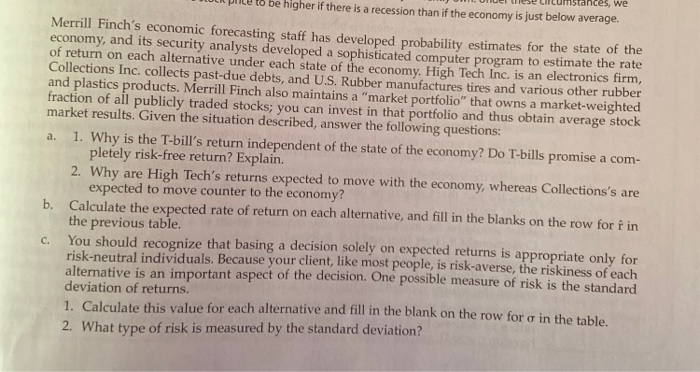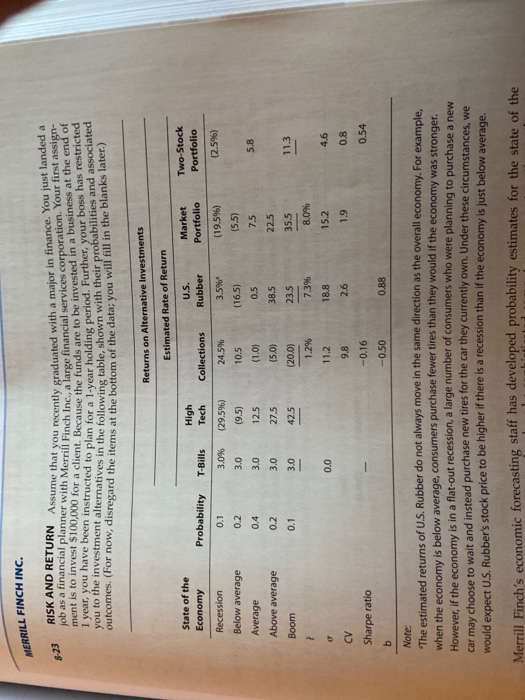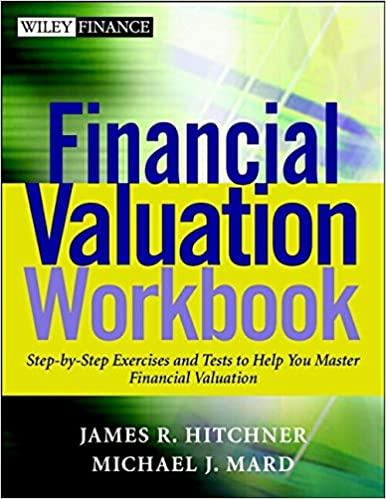JUM. Uluer lese licumstances, we LR pile to be higher if there is a recession than if the economy is just below average. Merrill Finch's economic forecasting staff has developed probability estimates for the state of the economy, and its security analysts developed a sophisticated computer program to estimate the rate of return on each alternative under each state of the economy. High Tech Inc. is an electronics firm, Collections Inc. collects past-due debts, and U.S. Rubber manufactures tires and various other rubber and plastics products. Merrill Finch also maintains a "market portfolio" that owns a market-weighted fraction of all publicly traded stocks; you can invest in that portfolio and thus obtain average stock market results. Given the situation described, answer the following questions: a. 1. Why is the T-bill's return independent of the state of the economy? Do T-bills promise a com- pletely risk-free return? Explain. 2. Why are High Tech's returns expected to move with the economy, whereas Collections's are expected to move counter to the economy? b. Calculate the expected rate of return on each alternative, and fill in the blanks on the row for fin the previous table. C. You should recognize that basing a decision solely on expected returns is appropriate only for risk-neutral individuals. Because your client, like most people, is risk-averse, the riskiness of each alternative is an important aspect of the decision. Une possible measure of risk is the standard deviation of returns. 1. Calculate this value for each alternative and fill in the blank on the row for a in the table 2. What type of risk is measured by the standard deviation? MERRILL FINCH INC. 8-23 RISK AND RETURN Assume that you recently graduated with a job as a financial planner with Merrill Finch Inc, a large financial services corp ment is to invest $100,000 for a client. Because the funds are to be in 1 year, you have been instructed to plan for a 1-year holding period. Furu. you to the investment alternatives in the following table, shown with their outcomes. (For now, disregard the items at the bottom of the data; you w at you recently graduated with a major in finance. You just landed a Inc., a large financial services corporation. Your first assign- because the funds are to be invested in a business at the end of o plan for a 1-year holding period. Further, your boss has restricted natives in the following table, shown with their probabilities and associated at the bottom of the data; you will fill in the blanks later.) Returns on Alternative Investments Estimated Rate of Return Probability Collections Two-Stock Portfolio (2.5%) State of the Economy Recession Below average Average Above average Boom T-Bills 3.0% 3.0 3.0 .0 3.0 0.2 0.4 0. 2 High Tech (29.5%) (9.5) 125 275 42.5 U.S. Rubber 3.5% (16.5) 0.5 38.5 24.5% 10.5 (1.0) (5.0) (20.0) 1.296 Market Portfolio (19.5) (5.5) 7.5 22.5 35.5 5.8 3 23.5 8.09% 7.3% 18.8 2.6 15.2 CV 11.2 9.8 -0.16 -0.50 19 Sharpe ratio 0.54 0.88 Note: The estimated returns of U.S. Rubber do not always move in the same direction as the overall economy. For example, when the economy is below average, consumers purchase fewer tires than they would if the economy was stronger However, if the economy is in a flat-out recession, a large number of consumers who were planning to purchase a new car may choose to wait and instead purchase new tires for the car they currently own. Under these circumstad would expect US Rubber's stock price to be higher if there is a recession than if the economy is just below average Merrill Finch's economic forecasting staff has developed probability estimates for the state of the








